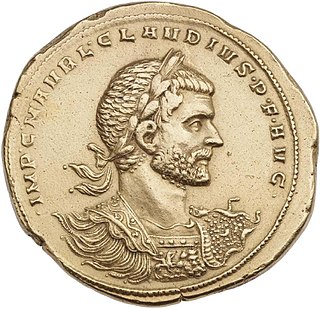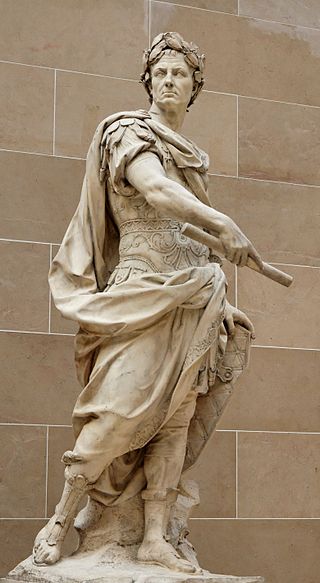Background
The barracks emperors tended to be low-class commoners, often from outlying parts of the empire. The first barracks emperor, Maximinus Thrax, had begun his military career as an enlisted soldier. A barracks emperor could not boast of a distinguished family name or a successful career as a statesman or public servant. Rather, he had only his military career to recommend himself, and his only influence had been though the soldiers loyal to his command.
Some of the soldier emperors were members of the equestrian class who had worked their way up to a sufficient position of influence within their legion that the soldiers would support a bid for power, but that was a risky undertaking because those soldiers could withdraw their support at any time and perhaps shift it to another military leader who looked more promising at the time.
Because the barracks emperors were frequently border commanders, the act of overthrowing the reigning emperor and seizing power for themselves left large gaps in the empire's border defences that could be exploited by Rome's enemies. That led to the Germanic incursion into Roman territory in the 260s and resulted in the construction of the Aurelian Walls around Rome. The barracks emperors also used state money to pay their troops since no emperor who had come into power by force of arms could afford to allow his soldiers to become disaffected, and public works and infrastructure fell into ruin. To accommodate the vast demands of buying off their soldiers, the state often simply seized private property, which damaged the economy and drove up inflation.
Transition to Dominate era
In 284, a barracks emperor, Diocletian, a cavalry commander, seized power. Diocletian instituted a number of reforms designed to stabilize the empire and the imperial office, brought an end to the Crisis of the Third Century and inaugurated the Dominate era of Roman history.
Although further emperors would don the purple on the basis of military power (such as Constantine I, Valentinian I, and Theodosius I) the phenomenon of the barracks emperors died out, to be replaced in the late imperial era by shadow emperors like Stilicho, Constantius III, Flavius Aëtius, Avitus, Ricimer, Gundobad, Flavius Orestes and Odoacer. They were military strongmen who effectually ruled the empire as imperial generalissimos controlling weak-willed puppet emperors, rather than taking the title themselves.

The Severan dynasty was an Ancient Roman imperial dynasty that ruled the Roman Empire between 193 and 235, during the Roman imperial period. The dynasty was founded by the emperor Septimius Severus, who rose to power after the Year of the Five Emperors as the victor of the civil war of 193–197, and his wife, Julia Domna. After the short reigns and assassinations of their two sons, Caracalla and Geta, who succeeded their father in the government of the empire, Julia Domna's relatives themselves assumed power by raising Elagabalus and then Severus Alexander to the imperial office.

The Tetrarchy was the system instituted by Roman emperor Diocletian in 293 AD to govern the ancient Roman Empire by dividing it between two emperors, the augusti, and their junior colleagues and designated successors, the caesares.

Marcus Aurelius Claudius "Gothicus", also known as Claudius II, was Roman emperor from 268 to 270. During his reign he fought successfully against the Alemanni and decisively defeated the Goths at the Battle of Naissus. He died after succumbing to a "pestilence", possibly the Plague of Cyprian that had ravaged the provinces of the Empire.

The Crisis of the Third Century, also known as the Military Anarchy or the Imperial Crisis (235–284), was a period in which the Roman Empire nearly collapsed. The crisis ended due to the military victories of Aurelian and with the ascension of Diocletian and his implementation of reforms in 284.

The following outline is provided as an overview of and topical guide to ancient Rome:

Gordian III was Roman emperor from 238 to 244. At the age of 13, he became the youngest sole emperor of the united Roman Empire. Gordian was the son of Antonia Gordiana and Junius Balbus, who died before 238. Antonia Gordiana was the daughter of Emperor Gordian I and younger sister of Emperor Gordian II. Very little is known of his early life before his acclamation. Gordian had assumed the name of his maternal grandfather in 238.

Gordian I was Roman emperor for 22 days with his son Gordian II in 238, the Year of the Six Emperors. Caught up in a rebellion against the Emperor Maximinus Thrax, he was defeated by forces loyal to Maximinus, and he committed suicide after the death of his son.

The Praetorian Guard was an elite unit of the Imperial Roman army that served as personal bodyguards and intelligence agents for the Roman emperors.

Marcus Clodius Pupienus Maximus was Roman emperor with Balbinus for 99 days in 238, during the Year of the Six Emperors. The sources for this period are scant, and thus knowledge of the emperor is limited. In most contemporary texts he is referred to by his cognomen "Maximus" rather than by his second nomen Pupienus.
The praetorian prefect was a high office in the Roman Empire. Originating as the commander of the Praetorian Guard, the office gradually acquired extensive legal and administrative functions, with its holders becoming the Emperor's chief aides. Under Constantine I, the office was much reduced in power and transformed into a purely civilian administrative post, while under his successors, territorially-defined praetorian prefectures emerged as the highest-level administrative division of the Empire. The prefects again functioned as the chief ministers of the state, with many laws addressed to them by name. In this role, praetorian prefects continued to be appointed by the Eastern Roman Empire until the reign of Heraclius in the 7th century AD, when wide-ranging reforms reduced their power and converted them to mere overseers of provincial administration. The last traces of the prefecture disappeared in the Byzantine Empire by the 840s.

The Dominate, also known as the late Roman Empire, is the despotic form of imperial government of the late Roman Empire. It followed the earlier period known as the Principate. Until the empire was reunited in 313, this phase is more often called the Tetrarchy.

The Year of the Six Emperors was the year AD 238, during which six men made claims to be emperors of Rome. This was an early symptom of what historians now call the Crisis of the Third Century, also known as Military Anarchy or the Imperial Crisis, a period in which the Roman Empire nearly collapsed under the combined pressures of foreign invasions and migrations into the Roman territory, civil wars, peasant rebellions, political instability, Roman reliance on foreign mercenaries known as foederati and commanders nominally working for Rome, the devastating social and economic effects of the plague, debasement of currency, and economic depression. The crisis ended with the ascension of Diocletian and his implementation of reforms in 284.
Rome's military was always tightly keyed to its political system. In the Roman Kingdom the social standing of a person impacted both his political and military roles, which were often organised into familial clans such as the Julia. These clans often wielded a large amount of power and were huge influences through the Roman Kingdom into the Roman Republic. The political system was from an early date based upon competition within the ruling elite, the patricians. Senators in the Republic competed fiercely for public office, the most coveted of which was the post of consul. Two consuls were elected each year to head the government of the state, and would be assigned a consular army and an area in which to campaign. From Gaius Marius and Sulla onwards, control of the army began to be tied into the political ambitions of individuals, leading to the First Triumvirate of the 1st century BC and the resulting Caesar's civil war. The late Republic and Empire was increasingly plagued by usurpations led by or supported by the military, leading to the Crisis of the third century in the late empire.

Castra Praetoria were the ancient barracks (castra) of the Praetorian Guard of Imperial Rome.
In historiography, the Later Roman Empire traditionally spans the period from 284 to 641 in the history of the Roman Empire.

The constitution of the late Roman Empire was an unwritten set of guidelines and principles passed down, mainly through precedent, which defined the manner in which the late Roman Empire was governed. As a matter of historical convention, the late Roman Empire emerged from the Roman Principate, with the accession of Diocletian in AD 284, his reign marking the beginning of the Tetrarchy. The constitution of the Dominate outrightly recognized monarchy as the true source of power, and thus ended the facade of dyarchy, in which emperor and Senate governed the empire together.

The Battle at the Harzhorn took place in the early 3rd century between Germanic and Roman troops near the Harzhorn hill between the towns of Kalefeld and Bad Gandersheim, in the state of Lower Saxony, Germany.

Gaius Julius Verus Maximinus "Thrax" was a Roman emperor from 235 to 238.
The history of the Later Roman Empire covers the history of the Roman Empire from the beginning of the rule of Diocletian in 284 AD and the establishment of the Tetrarchy in 293 AD by Diocletian to the death of Heraclius in 641 AD.












